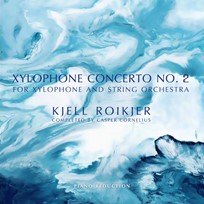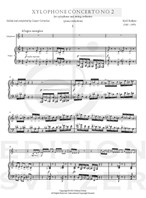
Xylophone Concerto No. 2 (Piano Reduction)
Composer: Kjell Roikjer
Instrument: Xylophone and Symphony Orchestra
Level: Advanced
Published: 2021
Price: €45.00
Item details
-
Description +
-
Edited and completed by Casper Cornelius
PrefaceWhen Edition Svitzer was contacted in 2011 by the then timpanist in The Royal Danish Orchestra Søren Monrad, Monrad's announcement was clear and distinct. He had come into possession of something very valuable, which under no circumstances should be lost. During a tour of the Royal Danish Academy of Music, Monrad had spotted some handwritten pages by Kjell Roikjer. One of the pages was provided with the heading Concerto No. 2 for xylophone and string orchestra.
Monrad found no indication of when the work should have been composed. But when Roikjer's first xylophone concerto was among his most acclaimed works, it was with great enthusiasm that Monrad began to read through the newfound work. He made an agreement with Edition Svitzer that the publisher should keep the material safely stored and begin further work when the timing felt right. In the middle of the pandemic in 2020, the timing was finally as it should be, and consequently Edition Svitzer began to put the pages together. It was clear that the third movement of the work was incomplete, the cadence in the first movement was lacking and that there was extensive work to decipher the faded copy of the handwritten manuscript. After careful consideration, it was decided that the composer Casper Cornelius should take on the task of editing and finishing composing Roikjer's dazzling work. Based on studies of Roikjer's other works, Cornelius has sought to complete the work in the same style and spirit.
Edition Svitzer's most important task since the beginning has been to protect the cultural heritage both at home and abroad. Our mission is cemented with the release of Roikjer's Concerto No. 2 for xylophone and string orchestra (this is the piano reduction), and we hope that you will take very well to the close-lost work that you now have in your hands.
It is the publisher's ambition to have the work orchestrated for string orchestra, in accordance with the original score from the composer. This material will then be offered as rental material containing string parts and conductor score.
-
-
Instrumentation +
-
Xylophone and String Orchestra
-
-
About the composer +
-
Swedish Kjell Roikjer was born in Malmö in 1901 and was first introduced to music when, as a very young man, he began to receive instruction in violin. As a 17-year-old, he traveled to Copenhagen, where after a couple of years he took on the bassoon as his main instrument, because he knew that there was a widespread shortage of bassoons in the Danish capital. He studied with the solo bassoonist Knud Lassen in the The Royal Danish Orchestra, and in 1924 he himself was employed as a solo bassoonist in the Helsingborg Symphony Orchestra. When he returned to Copenhagen in 1926, he got a permanent place as an assistant in the newly started Radio Symphony Orchestra, and two years later Roikjer became a Danish citizen.
Roikjer's work in music is characterized by a massive composition repertoire. When he died at the age of 98 in 1999, he had composed about 100 pieces, and Roikjer is one of the most played composers of his generation.
Although Roikjer's music may be melodically reminiscent of Carl Nielsen's, his repertoire is generally characterized by a form of French classicism that sharply contrasts Nielsen's distinctly modern style. Roikjer is often distinguished by an incomparable ear for both tonality and dynamics, and this is clear from compositions such as Concerto No. 2 for xylophone and string orchestra.
-
-
Reviews +
-
Review (Percussive Notes, February 2022)
This concerto is newly released, as the music was found in the Royal Danish Academy of Music and has been cleaned up for publication. The work was started by 20th-century Danish composer and bassoonist Kjell Roikjer (1901–99), but never finished. Composer Casper Cornelius was tasked with editing and finishing the concerto in the same style as the music that was given. There was no indication of the precise composition date.
The concerto is in three movements with the traditional fast-slow-fast format. The opening movement is exciting, consisting of fast sixteenth- note passages around the instrument, in mostly scalar fashion. A performer will need extreme accuracy to pull off these patterns at the indicated tempo. The second movement is slower with primarily rolled notes. The performer will need to use three mallets for this movement. The final movement is fast, and includes many passages that contain quick double stops. This movement is extremely technically difficult and will require a very accomplished player.
At the time of this writing there are no orchestra parts available; however, they will be coming soon. This would be a dazzling piece to put on any recital. The speed and accuracy needed will be sure to wow audiences of all types, and it will prove to be a huge accomplishment for the performer.
—Josh Armstrong
-
-
Credits +
-
Front Cover Graphics: Ronni Kot Wenzell
Editor: Casper Cornelius
Engraving: CPH Engraving
Printed in Copenhagen, Denmark
Copyright © Edition SVITZER
www.editionsvitzer.com
-


